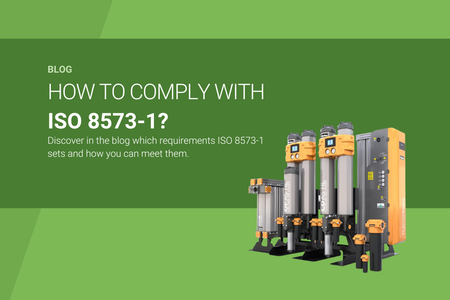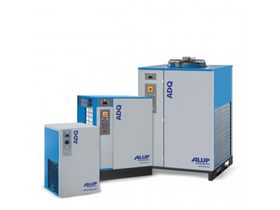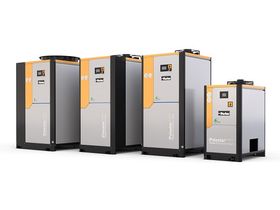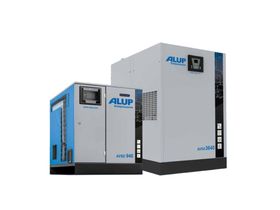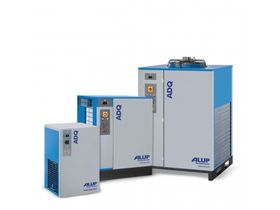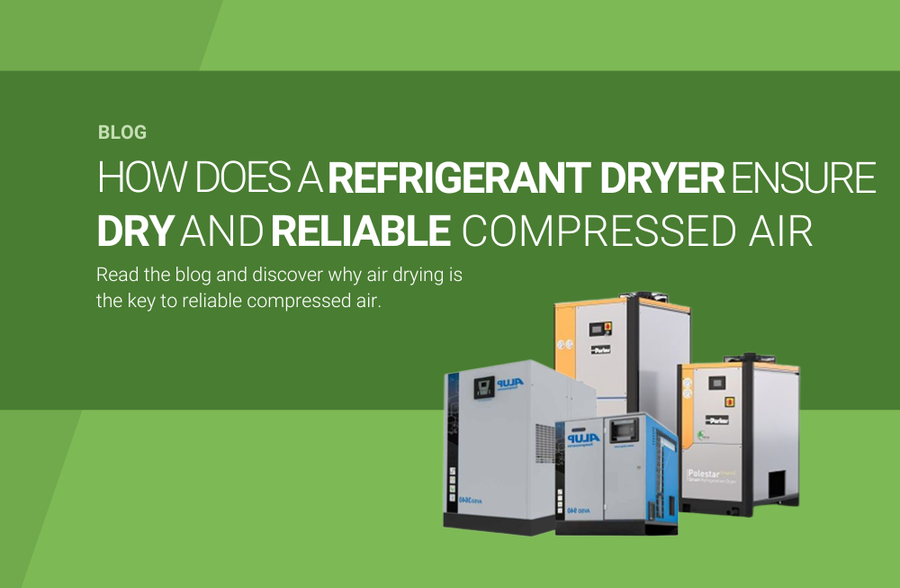
Moisture in compressed air can cause major damage over time, not only to pipes and valves, but also to machines, pneumatic tools and end products. Untreated compressed air can contain large amounts of moisture. Without proper drying, this moisture can lead to corrosion, leaks and malfunctions in sensitive components. Refrigeration dryers prevent this problem by drying the air before it enters the compressed air system. The result: dry, reliable compressed air and an installation that lasts longer.
What does a refrigeration dryer do?
A refrigeration dryer removes moisture from compressed air by cooling it down significantly, causing the water vapor to condense and the moisture to be automatically drained away. The remaining air is dry and prevents corrosion or damage to the system.
Refrigeration dryers lower the pressure dew point of compressed air to around +3 °C, corresponding to class 4–5 according to ISO 8573-1:2010. This makes them suitable for the majority of industrial applications where reliable, dry compressed air is required.
The principle is similar to that of an air conditioner: the compressed air is cooled, moisture condenses, and is removed. As a result, the system remains efficient, clean, and reliable. Modern refrigeration dryers are also characterized by low pressure drop and an energy-efficient refrigeration circuit, contributing to lower overall energy consumption.
When should you choose a refrigeration dryer over other air dryers?
There are several ways to remove moisture from compressed air systems. Refrigeration dryers are by far the most commonly used type of air dryer. In situations where dry air is essential but extremely low dew points are not required, refrigeration dryers offer the most practical and energy-efficient solution. Think of production environments, machine building or workshops where moisture can cause damage.
When very dry compressed air is needed — for example in the food, pharmaceutical industries or in outdoor applications where freezing may occur — an adsorption dryer is often the better choice. These dryers use a desiccant material to absorb moisture from the air and can achieve much lower dew points. Adsorption dryers are often used as a second stage after a refrigeration dryer, providing extra reliability in critical processes.
When a more compact solution is required for smaller air volumes, a membrane dryer can be used. These dryers contain a hygroscopic membrane that extracts moisture from the air and are especially suitable for low volumes or mobile applications.
Nevertheless, refrigeration dryers remain the ideal first step toward reliable, dry air in most compressed air systems. They combine stable performance with low energy costs and a long service life.
Hybrid compressed air dryers: the perfect mix
A hybrid compressed air dryer combines a refrigeration dryer and an adsorption dryer in one system. In the first stage, the air is cooled so that most of the moisture condenses and is discharged. Next, an adsorption stage with desiccant further dries the air to a lower dew point, making it even cleaner and drier. In fact, the air passes through two stages:
- Cooling stage: the air is first cooled in a heat exchanger, causing most of the moisture to be removed.
- Adsorption stage: the air then flows through a desiccant material that further dries it, achieving a lower dew point than with a standard refrigeration dryer. The pressure dew point can often be set to -20, -40 or -70 °C.
Thanks to this combination, the dryer achieves the performance of an adsorption dryer with lower energy consumption. The technology operates automatically and energy-efficiently, adjusting to air demand and ambient conditions.
Benefits of refrigeration dryers
Refrigeration dryers offer several advantages for compressed air installations:
- Extend the lifespan of machines and piping
- Prevent rust and moisture-related issues
- Reduce maintenance costs and downtime
- Maintain stable air quality
- Easy to install and maintain
Since refrigeration dryers operate with a fixed dew point of +3 °C, they are particularly suitable for standard industrial applications. Thanks to technological innovations, the refrigerants used are becoming increasingly environmentally friendly without compromising performance. As a result, today’s refrigeration dryers provide the optimal balance between energy efficiency, reliability, and drying capacity.
Refrigeration dryers from Avilo
Avilo offers a wide range of refrigeration dryers from leading brands such as Parker and Alup. These dryers are designed to deliver efficient performance under various conditions.
- Parker StarlettePlus-E and PoleStar Smart-E series: compact, energy-efficient refrigeration dryers with a constant pressure dew point of +3 °C, suitable for a wide range of industrial applications.
- Alup AVSD and ADQ series: robust, reliable dryers with high efficiency and optional frequency control for additional energy savings.
Our specialists are happy to advise you on which refrigeration dryer best suits your installation, depending on capacity, pressure, ambient temperature and energy efficiency.
Would you like more information or non-binding advice about refrigeration dryers? Please feel free to contact us.
 EN
EN
 NL
NL

